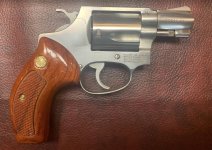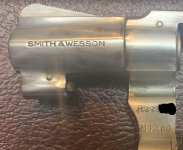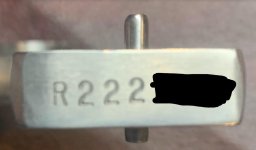The Mod. 60 marking inside the yoke cut looks like a Laser etch cut marking.
The ser# above it is punched numbers.
Bbl is a roll die marking.
The ser# on the butt of the frame is kind of hard to figure from the pic.
It looks like either a Laser cut or might be cut with a HS Rotary Point using a Pantograph type setup.
The pantograph machines were kind of popular in the 80's and 90's for smaller shops and one-of jobs.
You can ID the work from one by very careful inspection of the letters/numbers that are cut.
They will display the swirling rotary point marks down in the cuts that are left as the point cuts them.
Also the ends and rt angle corners of the figures are always left with a very small radius. Never a squared off cut.
That's from the round point cutter and the rotary action of the point in cutting the figures.
The bottoms of the cuts will be round bottom as well in most all cases.
If Laser cut, they can be square cut bottoms to the figures though not absolutely clean cut. The Laser of the time left a bit of a ragged cut. Some were better than others.
..then it may just be a standard M60 butt stamp ser# stamp from that era,,but it looks a bit different to me.
Pakistan is cut with a narrow Flat graver.
Held up on one edge to cut the narrow thin lines. Then let the graver dip down gradually as you cut to allow the 'flat' to engage the surface,,that produces the flared, wider cut on some letters. Pull the graver back up as you reach the opposite end to narrow the flare back to a thin line again.
The full width of the Flat graver is used occassionally to cut the verticle line of some letters.
It's a slightly faster way to cut Script Lettering by using one graver.
The standard method taught is to use a V point for the first process and then a separate Flat graver for the second bold wider cuts.
I took up the faster method! and actually did my scroll engraving using this early on. It was much easier to sharpen a Flat graver than a V point.






